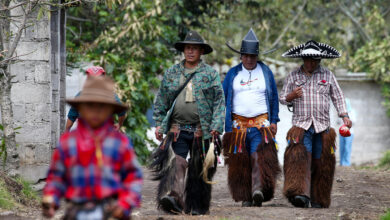Ecuador’s Biodiversity Efforts Bolstered by New Biobank Network

Establishing a national biobank network supported by South Korean funding and technological expertise will significantly boost Ecuador’s biodiversity conservation. The network aims to preserve the country’s unique genetic resources.
Ecuador’s National Institute of Biodiversity (Inabio) has recently secured crucial funding to enhance its National Genetic Resources Data Bank Laboratory. This initiative will form a nationwide network of seven biobanks to conserve Ecuador’s rich biodiversity. This project, bolstered by a substantial $9 million (approximately €8.28 million) grant from South Korean cooperation, signifies a significant step forward in the country’s conservation efforts.
As part of the initial phase, Inabio received around $50,000 (approximately €46,000) from the South Korean partnership to acquire transport and cryopreservation containers for genetic material. Inabio emphasized in its announcement that this project represents a significant transfer of knowledge and technology, essential for enhancing Ecuador’s research capabilities regarding the benefits and applications of its biodiversity.
“This inclusive project will serve as a consultation and study reference for the Ecuadorian population, including students, researchers, experts, and technicians in life-related productive areas,” stated Inabio.
Nicknamed “Ecuador’s Noah’s Ark of Biodiversity,” the biobank network will include the National Institute of Agricultural Research (Iniap), the University of the Armed Forces (Espe), Yachay Tech, the Amazon Regional University Ikiam, the National Center for Aquaculture and Marine Research of the Polytechnic School of the Coast (Cenaim-Espol), and the Private Technical University of Loja (UTPL).
Historical Context of Biodiversity Conservation in Ecuador
Ecuador, a small yet incredibly biodiverse country, has long been a global focal point for conservation efforts. Home to the Galápagos Islands, one of the world’s most famous natural laboratories, Ecuador’s unique ecosystems have been the subject of international scientific interest since Charles Darwin’s time. However, the country faces ongoing challenges in balancing development with conservation.
In the 1980s and 1990s, Ecuador saw rapid deforestation and habitat loss due to agricultural expansion and logging. These activities threatened many of the country’s endemic species, sparking local and international conservation initiatives. Over the years, Ecuador has made significant strides in protecting its natural heritage. Establishing national parks and reserves, such as the Galápagos National Park and the Yasuni National Park in the Amazon, have been critical in these efforts.
The new biobank network represents the latest advancement in Ecuador’s long-standing commitment to biodiversity conservation. By preserving genetic materials from diverse species, the country aims to safeguard its natural resources against future threats, including climate change and habitat destruction.
Biobanks play a crucial role in conserving genetic diversity. These repositories store genetic materials, such as seeds, tissues, and DNA, under controlled conditions to ensure longevity. By maintaining a genetic repository, biobanks enable researchers to study and utilize genetic resources for various applications, including agriculture, medicine, and environmental restoration.
In Ecuador, the establishment of a national biobank network will enhance the country’s capacity to protect its biodiversity. Integrating advanced technology and international expertise through the South Korean partnership will significantly bolster these efforts. This collaboration provides financial support and facilitates the transfer of cutting-edge techniques and methodologies essential for effective biobanking.
Educational and Research Implications
The new biobank network will be a valuable resource for Ecuadorian students, researchers, and professionals. Universities and research institutions nationwide will have access to preserved genetic materials, enabling them to conduct advanced studies in various fields. This access will foster innovation and contribute to the global body of knowledge on biodiversity conservation.
In particular, institutions like Yachay Tech and the Amazon Regional University Ikiam, which focus on scientific and technological research, will benefit significantly. These universities are well-positioned to lead groundbreaking studies on the applications of genetic resources, from developing new agricultural practices to discovering novel medicinal compounds.
Ecuador’s efforts to conserve its biodiversity resonate beyond its borders. The country’s approach to environmental conservation serves as a model for other Latin American nations facing similar challenges. Latin America, home to some of the world’s most diverse ecosystems, including the Amazon rainforest, faces ongoing threats from deforestation, climate change, and economic development pressures.
Countries across the region have made varying degrees of progress in addressing these issues. For instance, Brazil’s Amazon Fund, aimed at reducing deforestation, and Costa Rica’s successful reforestation programs highlight the diverse strategies employed to protect natural resources. Ecuador’s biobank network adds to these efforts, providing a replicable model for preserving genetic diversity.
The international collaboration aspect of this project is particularly noteworthy. South Korea’s support underscores the importance of global cooperation in tackling environmental challenges. Countries can collectively enhance their conservation efforts and address the global biodiversity crisis by sharing technology and expertise.
Future Prospects and Long-term Impact
Establishing the biobank network is a forward-looking initiative with the potential for significant long-term impact. By preserving genetic materials today, Ecuador is investing in the future resilience of its ecosystems. These efforts will help ensure the country’s rich biodiversity can withstand and adapt to environmental changes and human-induced pressures.
The biobank network is expected to expand its collections and improve its technological capabilities in the coming years. Continued international partnerships will be crucial in sustaining these efforts. Additionally, ongoing public engagement and education will be vital in fostering a conservation-minded society.
Also read: Ecuador’s Galapagos Islands Reveal Potential Hammerhead Nursery
Ecuador’s initiative to strengthen its biodiversity conservation by establishing a national biobank network represents a significant milestone in its environmental efforts. Supported by substantial funding and technological expertise from South Korea, this project underscores the importance of international collaboration in addressing global environmental challenges.
As Ecuador continues to lead in biodiversity conservation, the biobank network will serve as a critical resource for research, education, and innovation. By preserving its genetic resources, Ecuador is safeguarding its natural heritage and contributing to the global fight to protect biodiversity.




